

COOYAL, MARY ANN BUGG AND CAPTAIN THUNDERBOLT. COOYAL's own lady bushranger Babyfeet Caves (pic right and above), out near Bylong, were once home to the infamous Captain Thunderbolt, who was 'adopted' by local aboriginal people when he married Mary Ann Bugg, an Aboriginal woman.
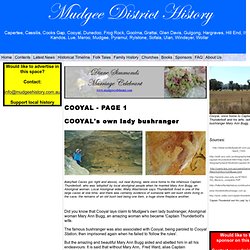
Local Aboriginal elder, Wally Washbrook says Thunderbolt lived in one of the large caves at one time, and there was certainly evidence of someone with old bush skills living in the cave, the remains of an old bush bed being one item, a huge stone fireplace another. Did you know that Cooyal lays claim to Mudgee's own lady bushranger, Aboriginal woman Mary Ann Bugg, an amazing woman who became 'Captain Thunderbolt's wife. The famous bushranger was also associated with Cooyal, being paroled to Cooyal Station, then imprisoned again when he failed to 'follow the rules'.
But the amazing and beautiful Mary Ann Bugg aided and abetted him in all his endeavours. See Kali Bierens book, " The Captain's Lady: Mary Ann Bugg" Also see: and. Captain Thunderbolt : About New South Wales. Born in Wilberfoce in Sydney's west in 1836, Frederick Ward was one of the second generation of New South Wales bushrangers.
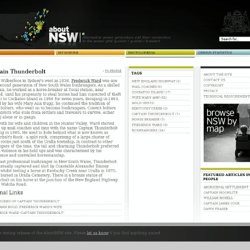
As a skilled horseman, he worked as a horse-breaker at Tocal station, near Maitland, until his propensity to steal horses had him convicted of theft and sent to Cockatoo Island in 1856 for seven years. Escaping in 1863, assisted by his wife Mary Ann Bugg, he continued the tradition of convict bolters, who went on to become bushrangers. Convict bolters were convicts who stole from settlers and travelers to survive, either working alone or in gangs. Living with his wife and children in the Hunter Valley, Ward started holding up mail coaches and inns with the name Captain Thunderbolt emerging in 1865.
He used to hide behind what is now known as Thunderbolt's Rock - a split rock, comprising of a large cluster of granite rocks just south of the Uralla township. "Captain Thunderbolt" bushranger & gentleman. Home | Our Family | Where We Live | Garden | Pets | More Pets | Family History | Stanthorpe Cemetery | E-mail & Guestbook | Quart Pot Creek | National Parks | Girraween N.P. | Boonoo Boonoo N.P. | Sundown N.

Captain Thunderbolt - Tocal's bushranger. Thunderbolt didn't kill anyone Thunderbolt was involved in several shootouts with police, so the fact that he never killed anyone may have been luck, but it added weight to the belief that Thunderbolt was the Gentleman Bushranger, the last of the professional highwaymen.
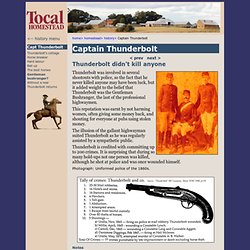
This reputation was earnt by not harming women, often giving some money back, and shouting for everyone at pubs using stolen money. The illusion of the gallant highwayman suited Thunderbolt as he was regularly assisted by a sympathetic public. Thunderbolt is credited with committing up to 200 crimes. It is surprising that during so many hold-ups not one person was killed, although he shot at police and was once wounded himself. Captain Thunderbolt. Frederick Ward Frederick Wordsworth Ward (aka Captain Thunderbolt) (1835–25 May 1870) was an Australian bushranger renowned for escaping from Cockatoo Island, and also for his reputation as the "gentleman bushranger" and his lengthy survival, being the longest roaming bushranger in Australian history.[1] Early years[edit] Frederick Ward was the son of convict Michael Ward ("Indefatigable" 1815) and his wife Sophia, and was born in 1835 around the time his parents moved from Wilberforce, New South Wales to nearby Windsor.[2] Ward entered the paid workforce at an early age, and was employed at aged eleven by the owners of Aberbaldie station near Walcha as a "generally useful hand" although he remained with them for only a short time.[3] He worked at many stations in northern NSW over the next 10 years, including the famed horse-stud Tocal, and his horsemanship skills soon became evident.
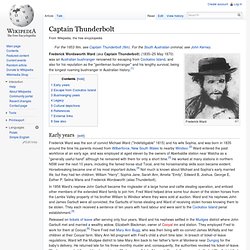
Escape from Cockatoo Island[edit] Bushranging years[edit] Frederick (Captain Thunderbolt) Ward. Frederick Ward (1835-1870), bushranger, alias 'Captain Thunderbolt', was born at Windsor, New South Wales.
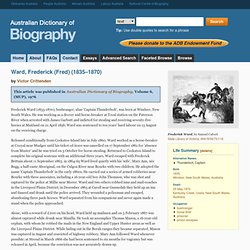
He was working as a drover and horse-breaker at Tocal station on the Paterson River when arrested with James Garbutt and indicted for stealing and receiving seventy-five horses at Maitland on 21 April 1856; Ward was sentenced to ten years' hard labour on 13 August on the receiving charge. Released conditionally from Cockatoo Island late in July 1860, Ward worked as a horse-breaker at Cooyal near Mudgee until his ticket-of-leave was cancelled on 17 September 1861 for 'absence from Muster' and he was tried on 3 October for horse-stealing.
Returned to Cockatoo Island to complete his original sentence with an additional three years, Ward escaped with Frederick Brittain about 11 September 1863. in 1864-65 Ward lived quietly with his 'wife', Mary Ann, née Bugg, a half-caste Aboriginal, on the Culgoa River near Bourke with two children. Captain Thunderbolt - Tocal's bushranger. Thunderbolt's Cottage Fred Ward worked at Tocal before becoming the notorious bushranger Captain Thunderbolt.
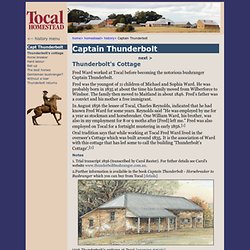
Fred was the youngest of 11 children of Michael and Sophia Ward. He was probably born in 1835 at about the time his family moved from Wilberforce to Windsor. The family then moved to Maitland in about 1846. Fred's father was a convict and his mother a free immigrant. In August 1856 the lessee of Tocal, Charles Reynolds, indicated that he had known Fred Ward for some years.
Oral tradition says that while working at Tocal Fred Ward lived in the overseer's Cottage which was built around 1835. Notes 1. Australian Crimes - BUSHRANGERS.